Campfires are considered one of the highlight moments with any camping adventure, and for good measure, the campfire offers a whole different experience in itself. To rate the success of your campfire, you can easily tell by the feelings and emotions it elicits in those who experience it.
Like most other things outdoors, the camping experience is all about working with your environment and being one with it. Regardless of it being outdoors, it is the home of other plants and animals, and you should therefore try as much as you can to exercise care and compassion for the environment in all the things you do while camping.
Starting the Ultimate Campfire
As stated above, how you’ll go about building a campfire that will work for you is dependent on your surroundings as well as the materials you have at your disposal. Though starting most campfires is straightforward, the task usually comes in when you have to keep the fire burning at just the right levels all through the night.
Supplies You’ll Need to Start a Campfire
Wood
For most camping expeditions, the most widely used and recommended source of fuel for campfires is wood. The importance of the nature of wood you use for your campfire cannot be overstated, and therefore this should make one of your primary points of focus whenever you’re planning for a campfire.
Though there are different types of wood available, we recommend that you use locally available wood or that which is sourced within a radius of not more than fifty miles of your campsite. The use of locally sourced wood is to help preserve the local environment’s ecosystem by preventing the introduction of foreign microorganisms on the foreign wood or insects that may threaten the local plants.
Depending on local policies, some camping sites also tend to dictate that campers use only wood sourced from local businesses. This approach is more from an economic perspective, where the rules are aimed at helping protect local businesses that provide camping equipment like wood.
Staying away from ‘professional’ camping jargon, wood is the general term used to refer to the primary substance used to fuel the fire. But from a more in-depth perspective, there are different types of forms in which the wood can be in, all of which are used at different levels of building the ultimate campfire.
1. Tinder
Tinder is usually made up of the smallest pieces in the fire-starting arsenal and is in the form of small wood chippings, dried leaves, twigs, or dried moss. Tinder is ever so important in the campfire starting process because it’s the easiest to catch fire with the least effort required. It’s worth noting that while tinder may catch fire pretty fast, it also burns out as fast, and therefore you should be on standby with other substances that can keep the flames going for longer.
2. Kindling
Kindling can be thought of as being in the middle between tinder and firewood, though leaning slightly more towards the tinder side. Kindling comprises thin branches and twigs, which catch fire easier than firewood and burn for longer than tinder. The role of kindling in the buildup of the campfire is to sustain the flames from the kindling, all while spreading it to and igniting the wood.
While getting your tinder burning may be as easy as striking a match, the real work is in ensuring that the firewood catches on to the fire. Therefore, you should always ensure that you have access to enough kindling to ease the process.
3. Fuel/Firewood
As you might have guessed, firewood makes for the final fuel that would be used to keep the campfire burning for as long as you’d want it to. This consists of large planks or logs of dry wood that are used to sustain the fire.
Fire-Starting Equipment
The choice of the tool to use when starting the spark or flame for your campfire is mostly a matter of personal preference. Whether you’re confident in your ability to get a fire going by using just a pair of sticks, or you enjoy the comfort of just using a lighter, we recommend that you consider having with you two or more options for your flame or spark source.
Even with world-class knowledge about the skills required for campfires, it all comes down to whether or not you can get that first spark or flame started. Therefore, this area should not be left to chance or make it a single point of failure. For the different fire-starting equipment available like lighters, matches, and fire starters, having all of them with you as you head out camping isn’t such a bad idea.
How to Build a Fire While Camping
While different campfires employ different building techniques, the underlying principles for getting the fire going are the same for most parts. One of the parameters used to tell apart different types of campfires is the nature of the site on which the campfire sits.
1. A Fire Pit
As the name suggests, this setup is usually made up of a metal cylinder that can be lightly pressed or raised above the ground. The idea behind fire pits is to ensure that the campfires can be easily contained and that the fire doesn’t spread from the specified area.
2. A Stone Ring
A stone ring campfire place is made up of a circular enclosure of stones inside which the campfire is set up.
Once you’ve identified and secured the site on which you want your campfire to be built, another precaution measure is to ensure that the area surrounding the fireplace has been cleared of any loose dry leaves or twigs that can spread the fire. With the location all set and the supplies assembled, follow the following steps to build your ultimate campfire:
3. Lay Down a Layer of Tinder
Tinder will make the bottom layer of your campfire buildup and should be shielded from any wind or breeze. Since flames are less dense than air, they burn to face upwards, which therefore makes sense for why you should have your fastest burning fuel at the bottom of the pile for it to propel the flames upwards.
4. Add your Kindling Material
Using dry kindling, you can either stack it on top of the tinder, or you could arrange the kindling sticks and twigs diagonally inclined around the tinder. With either of these approaches, the idea is to ensure that the kindling is close enough to the tinder, all while giving enough room for oxygen supply to the underlying flames. Whether you choose to stack up or prop up your kindling on top of the tinder, you should leave a little room for you to reach the starting spark or flame to the tinder.
5. Arrange the Wood
Depending on the type of buildup you are seeking for the start of your campfire, there are different approaches through which you can arrange the firewood. The different ways of laying out the firewood include:
- The Log Cabin – Placing two pieces of firewood parallel, one on either side of the tinder-kindling setup, and then two other pieces above the first two, albeit perpendicularly.
- The Cone – With this approach, place the firewood pieces diagonally erect around the kindling.
6. Start the Fire
After creating your campfire structure, start the fire using a lighter or match, and direct the flame towards the tinder.
While campfires make for a space of good times in the outdoors, they can be the source of unprecedented danger to you and your surroundings when left unchecked or done poorly. With this in mind, you should be ever so mindful whenever building or maintaining a campfire, and always be sure to put out the fire once you’re done with it.

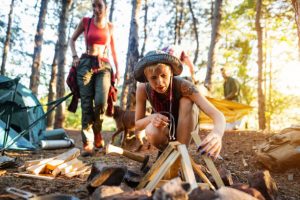
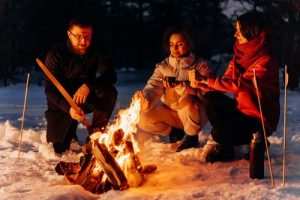
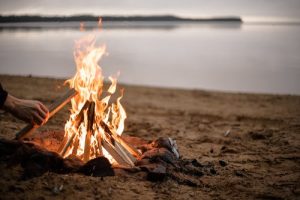
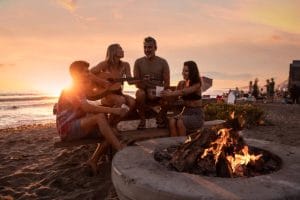
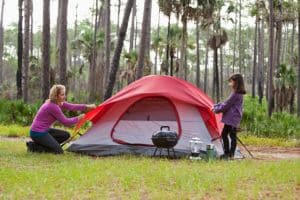
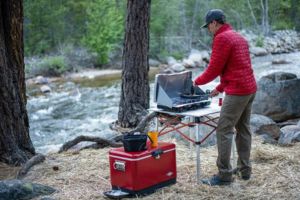
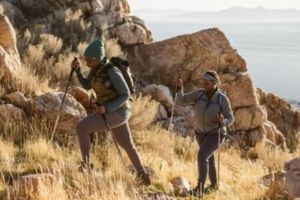
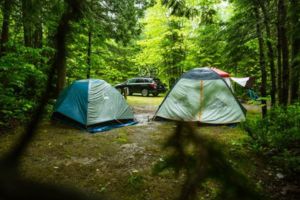
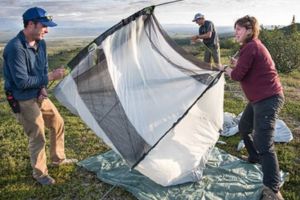
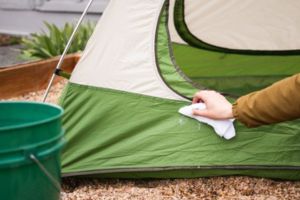
Leave A Comment